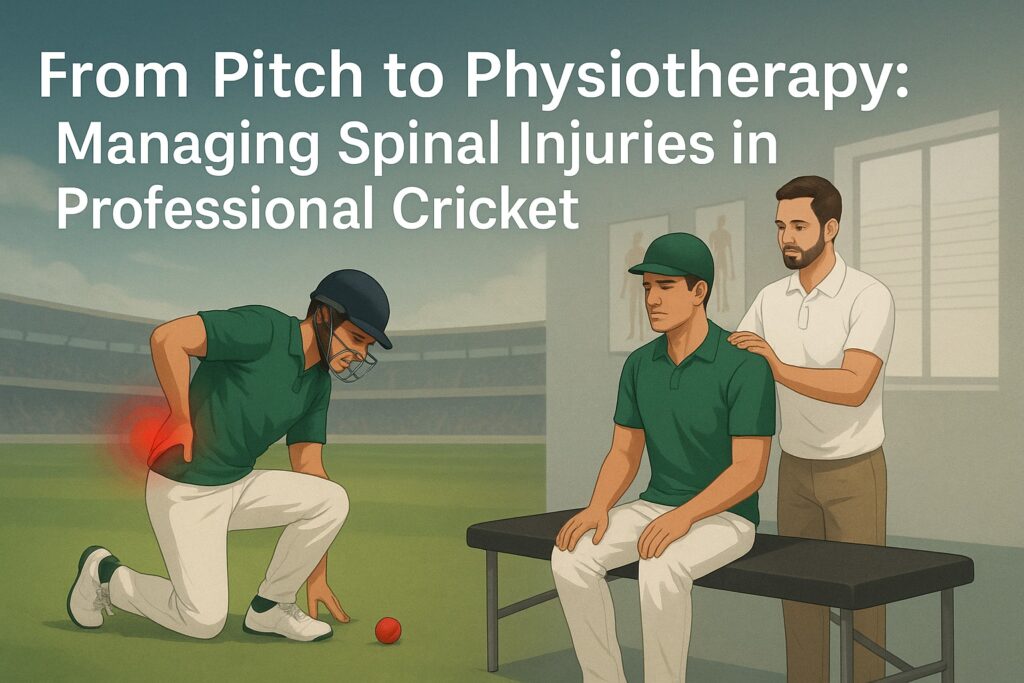
A Cricketer’s Worst Nightmare
Imagine being at the peak of your career – the adrenaline of the crowd, the tension in the air, and the weight of a match on your shoulders. You’re about to bowl the final over in a tense, closely contested match. But then, suddenly, a sharp, searing pain shoots through your lower back. It’s the kind of moment no cricketer ever wants to face, but unfortunately, it’s one that many will, at some point, have to contend with.
Cricketers, especially fast bowlers, put tremendous strain on their bodies day in and day out. The high-impact movements – from the explosive action of bowling to diving stops in the field – place immense pressure on their spine, making spinal injuries one of the most common and debilitating issues in the sport. In fact, research shows that about 60% of professional cricketers will experience some form of back pain during their careers, with fast bowlers being particularly vulnerable due to the repetitive nature of their bowling action.
When it comes to spinal injuries in cricket, the stakes are high. A back injury doesn’t just mean being sidelined for a few matches; it can potentially end a cricketer’s career. And yet, the role of physiotherapy in addressing these injuries cannot be overstated. From diagnosis to rehabilitation, physiotherapists are essential in helping players recover and get back to their peak form, both physically and mentally.
But how exactly do physiotherapists help cricketers bounce back? How do they balance the physical challenges of spinal injuries with the psychological pressure that comes with them? In this blog, we will explore how spinal injuries happen in cricket, what role physiotherapists play in managing them, and how players can avoid these injuries to prolong their careers.
The High-Risk Nature of Cricket: More Than Just a Game
Cricket isn’t just about hitting a ball with a bat or catching it mid-air. It’s a sport that demands constant high-impact movements, rapid twists, and physical endurance. But why are cricketers particularly prone to spinal injuries? Let’s break it down:
- The Bowlers’ Dilemma: Fast bowlers, especially, put intense stress on their spine with every delivery. The twisting motion, the heavy landing, and the sudden jolts all combine to put enormous pressure on the lower back.
- Fielding and Batting Strain: While it’s not as obvious as bowling, fielding, especially in positions like the slip or gully, involves quick reflexes, bending, and diving, which can also contribute to back pain. Batting isn’t immune either, with the twisting and repetitive nature of the stroke play.
It’s no surprise then that spinal injuries are common. But here’s the good news – prevention and treatment can make a huge difference.
What’s Really Happening to a Cricketer’s Spine?
Before we dive into treatment, it’s important to understand the types of spinal injuries that can occur:
- Stress Fractures: Often caused by repetitive stress, especially for fast bowlers who repeatedly rotate their spine during deliveries.
- Disc Herniation: A common injury where the cushioning discs between the vertebrae get damaged, causing radiating pain.
- General Back Strain: A broad category that includes muscle sprains or strains caused by sudden movements, bad posture, or overuse.
Each injury presents unique challenges, but physiotherapists have the skills to diagnose and treat them effectively.

Preventing a Career-Ending Injury: How Physiotherapists Help
Injury prevention is always better than cure, and cricketers need to make spinal health a priority. But how do they do that? Let’s look at the role physiotherapy plays in preventing injuries:
- Building a Strong Core: A powerful core supports the spine. Regular strengthening exercises ensure the muscles surrounding the spine are ready to take the strain.
- Biomechanics of Bowling and Batting: Physiotherapists often work with players on perfecting their technique to reduce unnecessary stress on the spine.
- Flexibility and Mobility: Stretching exercises and yoga are not just for flexibility but also for spinal alignment and reducing stiffness. A more flexible spine can absorb the shock of quick movements better.
Imagine a bowler who has been coached to adjust their technique, improving their spinal alignment and reducing the stress on their back. That’s the kind of proactive approach physiotherapists take in cricket.
The Road to Recovery: Getting Back on Track
So, what happens when the inevitable occurs? A cricketer has a spinal injury, and they need help getting back to playing their best. Here’s where physiotherapy really steps in:
- The Acute Phase: When the injury first happens, physiotherapists focus on reducing pain and swelling using methods like cold therapy, massage, or ultrasound. It’s not about pushing through the pain – it’s about rest, recovery, and gradual healing.
- Rehabilitation: Once the pain has subsided, the real work begins. Physiotherapists will guide players through specific rehabilitation exercises designed to strengthen the back and restore flexibility. Think of it like a custom workout plan to target the exact areas that need recovery.
- Gradual Return to Play: You can’t rush back onto the field after an injury, especially with spinal issues. A phased return-to-play plan is vital. Here’s where physiotherapists and coaches collaborate to ensure players don’t overdo it during recovery.
Not Just Physical: The Mental Game
The mental challenge of recovering from a spinal injury is often overlooked. But for cricketers, injury can be just as psychological as it is physical. The fear of re-injury or not returning to peak performance can play havoc with confidence.
How physiotherapists help mentally:
- Mental Resilience: Physiotherapists don’t just work on physical recovery. They can also help build mental resilience by setting achievable goals and encouraging patience during the recovery process.
- Mind-Body Connection: Focus on mindfulness, breathing exercises, and relaxation techniques. It’s about getting the mind in sync with the body to push through recovery.
Conclusion: A Spine in Good Hands
Managing spinal injuries in professional cricket is a delicate balance that involves prevention, treatment, and rehabilitation. With the intense physical demands of the sport, cricketers are at a high risk for back injuries, particularly due to the repetitive strain placed on their spines. However, thanks to the expertise and tireless efforts of physiotherapists, players are able to recover from these injuries and return to the field at their best.
Physiotherapists play a critical role in the early detection and rehabilitation of spinal injuries, using advanced techniques to speed up recovery and prevent further damage. They also focus on prevention, helping cricketers build stronger, more resilient spines through targeted exercises, proper posture, and injury management strategies.
Just as cricketers protect their bats and equipment, their spines deserve the same level of care and attention. By maintaining good physical conditioning, ensuring proper techniques, and committing to regular physiotherapy, players can avoid long-term damage and reduce their risk of serious injuries.
Ultimately, a healthy spine is essential for any cricketer’s career longevity. With the right care, a cricketer’s spine can be in good hands, allowing them to continue playing at the highest level, season after season, and keep their careers on track for years to come.